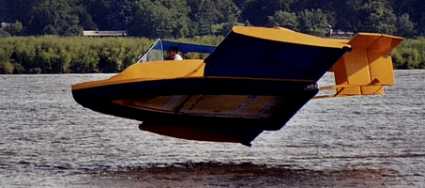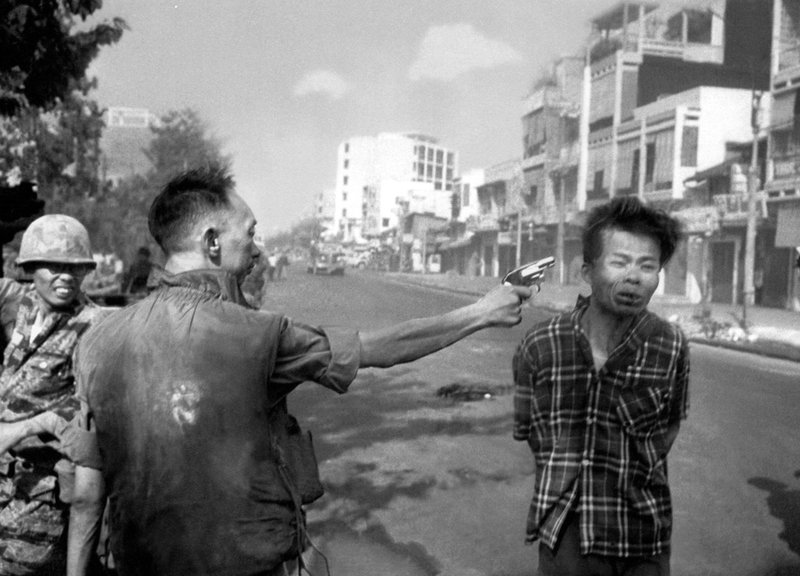Other related reading: Fred Fry International Maritime Monday 96 and Sunday Ship History: Putting RADAR on ships.
————————————-
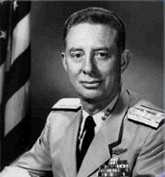
His name is Vice Admiral Lawson “Red” Ramage, USN. As Skipper of the USS PARCHE (SS-384) while wearing the rank of Commander, he led his crew in such an action as to be awarded the Medal of Honor(text of the Citation is
here).
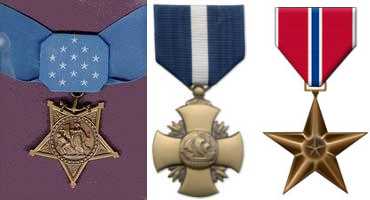
According to Wikipedia, VADM Ramage was awarded the MOH, two Navy Crosses and the Bronze Star.From the
NAVAIR website, some information about this combat leader’s career:
The third Medal of Honor awarded to a submariner in World War II was earned by then-CDR Lawson P. “RED” Ramage for a blistering night surface action against a Japanese convoy south of Taiwan in July 1944. For sheer excitement, it ranks among the greatest “shoot-em-up” tales in our Navy’s proud history.
A tall, genial redhead, Ramage was born in Monroe Bridge, Massachusetts on 19 January 1909 and graduated from the U.S. Naval Academy in 1931. After several years on surface combatants, he entered the Submarine School in mid-1935 and served for two years on USS S-29 (SS-134). Following a year at the Postgraduate School and a tour as Executive Officer on the destroyer USS Sands (DD-243), Ramage found himself on the Pearl Harbor staff of Commander, Submarines, Pacific, when war broke out on 7 December 1941.
He made his first war patrol as Navigator of USS Genadier (SS-210) in early 1942 and then assumed his first command- USS Trout (SS-202)- in June of that year. In his initial war patrol on Trout, in August 1942, now LCDR Ramage scored several hits on the Japanese light aircraft carrier Taiyo near Truk, the first damage inflicted by a U.S. submarine on a Japanese carrier. Although Taiyo survived the encounter, Ramage went on to sink three ships, totaling 5,800 tons, during his four war patrols on Trout. This total might have been significantly higher were it not for the duds and premature detonations that plagued U.S. torpedoes early in the war, and after seeing several of his attacks thwarted in this way, Ramage became an outspoken and effective critic of torpedo performance.
He returned to the United States in May 1943 to assume command of the Balao-class submarine USS Parche (SS-384), which he commissioned in November and brought out to the Pacific early in 1944. Parche departed Pearl Harbor on her first war patrol in March 1944, teamed with USS Bang (SS-385) and USS Tinosa (SS-283) to form “wolf pack” preying on Japanese shipping in the Luzon Strait, between Taiwan and the northern Philippines. After several unsuccessful pursuits, Parche drew her first blood on 4 May in a joint attack on a Japanese convoy in which two sinkings were credited to Ramage and his men, for a total of 11,700 tons.
“Red” Ramage’s Medal of Honor exploit occurred during Parche’s second war patrol, when she joined USS Steelhead (SS-280) and USS Hammerhead (SS-364) for another “wolf pack” patrol in the Luzon Strait during June and July 1944. For six weeks after leaving Midway on 17 June, the group had little success in locating the enemy, and their only kill was a small patrol craft sunk by Ramage with his deck gun. On 30 July, however, Hammerhead encountered a large convoy and moved in to attack after attempting to send its position to the other two boats. Hammerhead failed to score any kills, and even more unfortunately, her sighting report was so confused and misleading that Parche and Steelhead spent a full day searching for the convoy while being harassed by enemy aircraft. Finally, early on the morning of July 31, Parche and Steelhead found their quarry on radar, and the Steelhead – under CDR Dave Whelchel – attacked first, scored several hits, and withdrew to reload torpedo tubes.
Seeing his own chance, Ramage took Parche into the middle of the convoy on the surface and precipitated a 46 minute melee in which he single-handedly took on booth enemy escorts and merchantmen, firing 19 torpedoes in the process. Clearing the bridge of everyone but himself, Ramage threaded his way through two escorts and attacked first a freighter and then two tankers, scoring hits on all three. By now thoroughly alerted, the Japanese formation dissolved into confused welter of wheeling ships and escorts, with Parche maneuvering violently in their midst, both to get off shots of opportunity and to avoid a storm of enemy deck-gun fire of every caliber. At one point, while Parche was engaged with two anti-submarine escorts, a small freighter loomed out of the night attempting to ram her. Ramage slammed the rudder hard over, and the two vessels passed port to starboard at a distance of only 50-ft. This maneuver put Parche directly in the path of an oncoming passenger-cargo ship, the Manko Maru, and with little other choice, Ramage loosed three bow shots “down the throat” of the oncoming threat. Two torpedoes hit, slowing the victim down, but it took a quick turn to bring the stern tubes to bear for the coup de grace that sent Manko Maru to the bottom. At this point, as the remaining Japanese vessels fired fruitlessly into the night in all directions, and with no valuable targets nearby, Ramage pulled Parche out of the fight totally unscratched. Meanwhile, Whelchel, in Steelhead, returned to the fray on the other side of the convoy and sank at least one more ship before being forced out under hostile aircraft at first light.
While several other ships were damaged in the relentless attack, postwar reconstruction credited Parche and Steelhead with sinking two merchantmen each and collaborating on a fifth for a total of 39,000 tons of enemy shipping. And for his utter fearlessness, daring, and extraordinary tactical skill in successfully challenging an entire Japanese convoy to a night surface action, “Red” Ramage was awarded the Congressional Medal of Honor by a grateful nation.
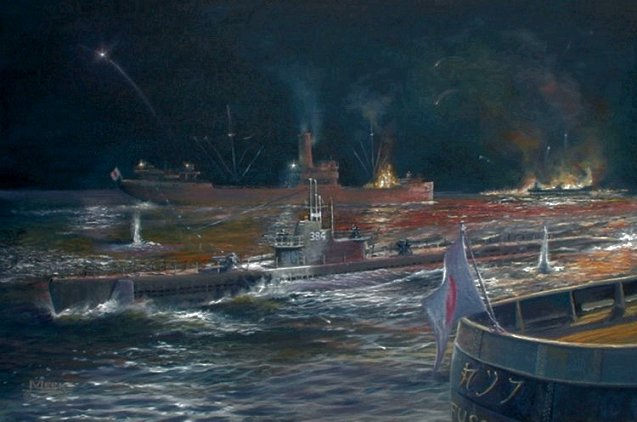
Painting by John Meeks. Click on the picture to go to the Sub Art Website Attributed to Red was the comment “I got mad!” From the
PARCHE website:
During the Parche’s second war patrol, she engaged in a predawn attack on a Japanese convoy on July 31, 1944. During this daring night surface action Parche worked her way in inside two escorts and began an approach on a medium AK at 0354. The target slid by about 200 yards away and then turned to avoid two torpedoes Parche had fired at her. That move effectively blocked an escort who had sneaked in behind her and also opened up an opportunity for shots at two tankers and the AK. A stern shot took care of the cargo carrier and four bow tubes knocked out a tanker. CDR Ramage ordered “Right-Full Rudder” to bring the stern tubes to bear on the second oiler and fired three torpedoes. One missed ahead of the ship but the other two fish hit the forward section slowing down the tanker but not stopping her completely.
The escorts opened up with deck guns, machineguns and flares firing in all directions. The convoy started to mill about smartly with Parche in the middle. Suddenly a medium sized merchant-man with a sizeable superstructure came in sight. The torpedo reload crews forward and aft reloaded tubes as fast as they could and Parche fired two tubes as soon as the outer doors were opened. The two torpedoes broke the merchant-mans back, which sent her down within a couple of minutes.
With the merchant-man out of the way Parche came back after the first tanker to finish her off. Parche crossed her track astern at only 200 yards. At 500 yards the tanker opened up on Parche with everything she had, but her trim down by the bow kept her from depressing her guns enough to do any good. The small arms fire was peppering the bridge enough that Ramage sent all hands below except the quartermaster, who stuck to the after TBT until he had the set-up. At 800 yards Parche fired three torpedoes from the stern tubes at the tanker. All hit the tanker with terrific explosions effectively silencing the gunfire from that quarter. With five torpedoes in her the big tanker gave and went down leaving only a small oil fire.
The two escorts on the port quarter were now concentrating their machine gun fire on Parche. Ramage was about to come right to put them astern and head for the prize of the evening, a huge transport, when she spotted a ship coming in sharp on the starboard bow apparently intent on ramming. Ordering a full bell, Ramage sent the boat shooting across in front of the on-rushing enemy, then halfway across its track he ordered “Right-Full Rudder” swinging right the stern of the boat out of its path. The Japanese were screaming like a bunch of wild pigs as Parche barely missed being rammed by less than 50 feet. All hands exchanged mutual cheers and jeers.
Parche, now boxed in on both sides by several small craft and the big transport dead ahead had no alternative but to fire straight down the transports throat. The first fish started off to the right, so Ramage checked fire, spotted on, and fired two more. These were right in the groove and both hit the transport stopping her cold. Closing in on her starboard bow, the Parche swung hard left and fired one stern shot at 800 yards for a bull’s eye.
Stopping to take account of the situation, Ramage counted eight ships still visible on her RADAR screen. The bewildered escorts were still busy firing weapons in the darkness at Parche and at each other. The big transport was stopped and down by the bow, but showed no further signs of going down. Just as Parche started back to deliver the felling blow, the transport suddenly raised its stern into the air and went straight down, head first into the cold depths of the ocean. Parche then began an egress from the area yet one of the escorts continually challenged her with weapons fire amid the sounds of loud explosions in the darkness. The entire attack took 46 minutes.
When Parche was finished, she had gotten the Japanese ships to open fire at one another, and had sunk a 10,238 ton tanker, a 4,471 ton passenger-cargo ship, damaged several thousand tons of Japanese ships ,and had disrupted yet another convoy. She also worked together with Steelhead in sinking an 8,990 ton transport. Steelhead sank two other ships, a transport and a cargo vessel. What made this more incredible was that this all occurred from the middle of a convoy of ships, on the surface, and at night. For this action Parche received the Presidential Unit Citation and Commander Ramage was awarded the Congressional Medal of Honor. The Submarine Combat Insignia was also authorized for the patrol.
[…]
Note to readers: That’s my kind of XO. Doing what the CO didn’t have time to do in the battle: Conducting “international relations.” Add to it CHAOS reigning supreme, and it being on your side. 46 minutes in combat as the target and not a casualty?
“Red” Ramage continued to serve, as did the PARCHE, when she was a target for the OPERATION CROSSROADS tests in 1946.
Again, from the NAVAIR site:
After the war, Ramage served in a number of Submarine Force positions, including command of Submarine Division TWO and Submarine Squadron SIX, as well as venturing into surface navy as Commanding Officer of the attack transport USS Rachin (AKA-103) following his promotion to Rear Admiral in July 1956, he served on the staff of the Chief of Naval Operations; as the Commander of Cruiser Division TWO; and as Deputy SUBLANT. In the latter capacity, he directed the successful search for the sunken USS Thresher (SSN-593) in April 1963. Later promoted to Vice Admiral, Ramage became the Deputy CNO (Fleet Operations and Readiness) and served as Commander, FIRST fleet, during the Vietnam buildup in 1964-1966. He retired in 1969 as the Commander, Military Sea Transportation Service. VADM Ramage died in 1990 and is buried in Arlington National Cemetery.

The guided missile destroyer USS RAMAGE (DDG-61), commissioned in July 1995, honors VADM Lawson Ramage’s service.The official website for USS RAMAGE (DDG-61) is
here.Commissioned July 2nd, 1995, a ship of the
ARLEIGH BURKE guided missile destroyer class, she is assigned to the Atlantic Fleet and has made here deployments to the Med and Arabian Sea to support Operation Enduring Freedom (in 2002). Her maiden voyage to the Med in November 1996 included joint anti-submarine warfare operations with countries around the Med. I was aboard for a week to evaluate the use of and train the crew on the test installation of the Computer Aided Ded Reckoning Tracer (CADRT).
I can’t find much history beyond 2002 on the web, but I’m certain RAMAGE has been an active deployer in operations since then. In 2006, she was attached to CTF 150 as noted in
this press release.

